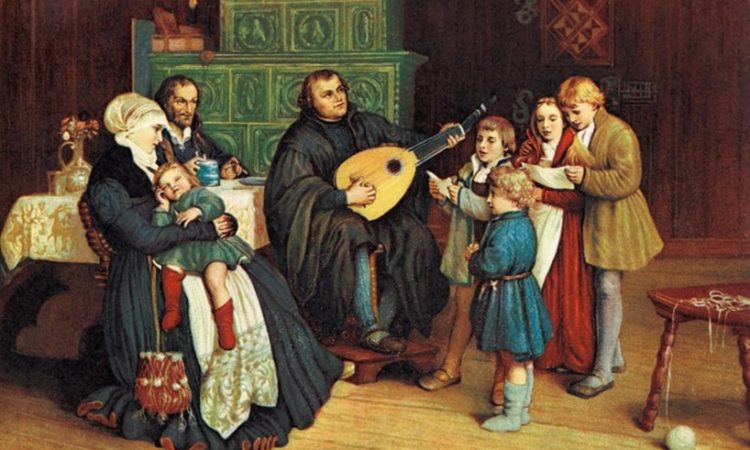
By Felipe Vogel
Everyone knows that the Reformation opened the floodgates of German songwriting, transforming the hymn into communal song. No less astonishing, but much less remembered, is the early Lutherans’ tireless work at writing an entirely new corpus of Latin hymns. The Lutherans’ use of these new Latin hymns—along with edited traditional hymns, parts of the old Latin liturgy in church services, and the Latin-heavy humanistic education of their children—leads Ann Moss to speak of “Lutheranism’s bilingual culture” in her monograph on Latin hymns during the Reformation. (See also her earlier monograph on Latin hymns in the decades before the Reformation. She shows that the Lutherans were following the lead of earlier Renaissance humanists, who overhauled the traditional hymns to suit their classical tastes.)
As fascinating as that story is, here we’ll pass over it and simply read and hear two hymns by George Fabricius, according to Moss “the most accomplished of Lutheran Latin hymn-writers [and] a humanist of the first rank.” As for the musical settings, the musical notation published in the 16th century in some hymn books for use by choirs of schoolboys is beyond my meager skill in reading music, so instead I’ve made up my own tunes that more or less follow the hymns’ iambic meter. Like any hymn, these are best appreciated with music!
“Christ Wearing the Crown of Thorns”
Heu! Quale nunc spectaculum
Mihi merenti sistitur.
Regi Angelorum et
Christo tiara rhamnus est
Transfixa foederantur rubis
Aculeatis tempora.
Rivi cruoris per caput
Et os serenum defluunt.
Da, Christe, membrum sim tuae
Semper virens Ecclesiae,
Et te sequar per grandia
Laeto gradu pericula.
Feram salutis cassidem
Conumque fulgentis spei,
Beatus olim ut induar
Tuae corona gloriae.
Translation:
Ah! What a sight I see,
deservedly.
The King of angels and the sky,
His forehead’s pierced, his face disfigured
by sharp thistles.
Rivers of blood flow down his head
Across his quiet face.
Christ, may I be a part of your Church,
Following you through awful dangers
With a cheerful step.
I’ll wear the saving helm, crested
with blazing hope,
Until in perfect joy someday
I don your crown of glory.

Albrecht Dürer, The Dead Christ with the Crown of Thorns, 1503.
“To the Holy Spirit on Pentecost”
Beate Patris Spiritus,
De luce lux altissima,
Piis rogamus ignibus
Incende nostra pectora.
Errore lapsos corrige
Ac inscientes instrue.
Te non docente, plena sunt
Densis tenebris omnia.
Da nos amemus intimis
Ut invicem praecordiis.
Sancto quod a te dissidet
Coniunge nexus vinculo.
Periclitantibus sacro
Adsis patronus numine,
Nec non propinques aspero
Solator in certamine.
Auge fidem, caelestia
Infunde largus munera.
Immitte fortes gloriam
Tuam fateri spiritus.
Attolle nostra lumina
Caeli videre praemia.
Non torpeat terrestribus
Mens implicata sordibus.
Legens tibi credentium
Sedem perennem pectorum,
Tuere dona, quae tuae
Inserviunt Ecclesiae.
Deus precum, preces pias
Esse efficaces perfice.
Cum Patre te, cum Filio
Omni canamus saeculo.
Translation:
Our Father’s blessed Spirit,
Of light the highest light,
Set our hearts ablaze
With fires of devotion.
Correct the wanderers, teach
Those who do not know.
All, without your teaching,
is mired in darkness thick.
Help us love each other
From deep within the heart.
Reforge the chains to things
From holiness removed.
Be near to those in danger,
As their divine protector.
Come close, our Comforter,
to us in dire troubles.
Increase our faith, pour out
your heavenly gifts in plenty.
Pour strength into our spirits
to confess boldly your glory.
Raise our eyes to see,
The rich rewards of heaven.
May our minds not falter,
Ensnared in worldly filth.
Claim the eternal seat
Of faithful, believing hearts!
Set a watch around
The gifts that serve your Church.
Make, O God of prayers,
Our prayers be efficacious.
With you, Father and Son,
We’ll sing through every age.

Albrecht Dürer, Pentecost, from The Small Passion, c. 1510.
Conclusion
We are right to drink deep from the well of theology dug for us by the early Protestants and the Latin intellectual tradition from which they drew, but alongside it flows a steady stream of other Latin writings, hymns among them, which can refresh our imagination and invigorate our worship. It is no mere brook: the hymns and other sacred poems of Fabricius alone fill 900 pages. Nor was it a short-lived creative outburst. Far into the 18th century we find 3000 lines on Christian faith and living, we find the Psalms and Song of Songs in verse, and we find a poetic rendering of Johann Gerhard’s Sacrae Meditationes—all in Latin, all classically refined, and yet stirring the heart toward God.
This rich Protestant tradition of Latin sacred poetry is becoming ever more accessible, thanks to the ongoing revival of the study of Latin, recently-published compendia such as The Oxford Handbook of Neo-Latin, and the convenience of online scans of centuries-old editions. So why not take a stroll up the bubbling stream?
Felipe Vogel and his wife Hannah teach in Liberia, West Africa, with the Rafiki Foundation. Felipe earned his M.A. at the University of Kentucky, where he lived every day in Latin at the Institute for Latin Studies.


One response to “Latin Hymns Reformed”
[…] of us may have been disappointed to see only Lutherans among the hymn-writers which we recently sampled. But fear not, Reformed readers, because Latin culture flourished in early Reformed circles as […]